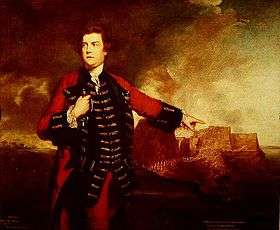George Keppel, 3rd Earl of Albemarle
| George Keppel Albemarle | |
|---|---|
 George Keppel, 3rd Earl of Albemarle | |
| Born | 8 April 1724 |
| Died | 13 October 1772 (aged 48) |
| Occupation | 3rd Earl of Albemarle |
General George Keppel, 3rd Earl of Albemarle KG PC (London, 8 April 1724 – 13 October 1772), styled Viscount Bury until 1754, was a British soldier and nobleman. He is best known for his capture of Havana in 1762 during the Seven Years' War.
Early life
He came from a wealthy and powerful Dutch family from Gueldres close to the Princes of Orange that had moved to England in the seventeenth century. His father was Willem van Keppel, 2nd Earl of Albemarle. Through his mother, Lady Anne Lennox, he was a great-grandson of King Charles II of England. He started his military career in the Netherlands fighting against the French and in 1745 participated in the Battle of Fontenoy as an aide to Prince William, Duke of Cumberland.
Capture of Havana
The European-American conflict known as the Seven years war brought his course to participate in July 1762, with two of his cadet brothers, Augustus Keppel and William Keppel, in the attempts by the British Crown to conquest, through a naval expedition headed by Sir George Pocock, (1706–1792), promoted to Admiral in 1761, the Caribbean Island of Cuba, i.e. the invasion and occupation of Havana and west Cuba:

George Keppel had been previously in his military life commissioned an ensign in the Coldstream Guards in 1738, becoming a captain-lieutenant of the 1st Regiment of Dragoons in 1741, aged 17, and a captain-lieutenant of the Coldstreams on 7 April 1743. Appointed aide-de-camp to the Duke of Cumberland in February 1745, was promoted to captain and lieutenant-colonel on 27 May 1745. The next year, he was promoted colonel and made aide-de-camp to the King on 24 April 1746. He had fought at the Battle of Culloden with his father and carried the dispatch of Cumberland's success to London.
Bury, later 3rd Earl of Albemarle, was returned as Member of Parliament for Chichester in 1746. He was appointed a Lord of the Bedchamber to the Duke of Cumberland in 1748, a post he held until the Duke's death in 1765. On 1 November 1749, he was given the colonelcy of the 20th Regiment of Foot. He succeeded to the earldom on the death of his father in 1754; his younger brother Augustus replaced him as MP for Chichester.
On 8 April 1755, he became colonel of the 3rd (The King's Own) Regiment of Dragoons. He was promoted major-general on 1 February 1756 and lieutenant-general on 1 April 1759. He was appointed Governor of Jersey on 26 January 1761 and sworn a Privy Counsellor on 28 January.
Keppel was the commander-in-Chief of the invasion and occupation of Havana and west Cuba in 1762. His younger brothers, Capt. Augustus and Col. William Keppel, both took part in the expedition as well. After a difficult siege, wherein the troops suffered heavily from yellow fever, Havana's Morro Castle was taken and Havana fell into British hands.
Later life
Keppel was made a Knight of the Garter in 1765 was appointed Keeper of Bagshot Park in 1766. In 1770, he married Anne Miller, daughter of Sir John Miller, 4th Baronet by whom he had a son, William Charles (1772–1849).
Politically, he was a prominent member of the Rockingham Whigs in the House of Lords. He was made a general on 26 May 1772, and died in October of that year.
See also
External links
References
- Doyle, James William Edmund (1885). The Official Baronage of England. London: Longmans, Green. p. 35. Retrieved 14 June 2008.
| Parliament of Great Britain | ||
|---|---|---|
| Preceded by James Brudenell John Page |
Member of Parliament for Chichester with John Page 1746–1754 |
Succeeded by John Page Augustus Keppel |
| Military offices | ||
| Preceded by Lord George Sackville |
Colonel of the 20th Regiment of Foot 1749–1755 |
Succeeded by Philip Honywood |
| Preceded by The Lord Tyrawley |
Colonel of the 3rd (The King's Own) Regiment of Dragoons 1755–1772 |
Succeeded by Charles FitzRoy |
| Peerage of England | ||
| Preceded by Willem Keppel |
Earl of Albemarle 1754–1772 |
Succeeded by William Keppel |